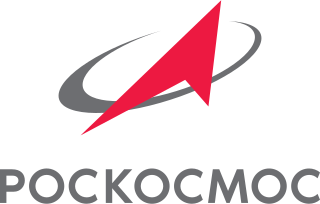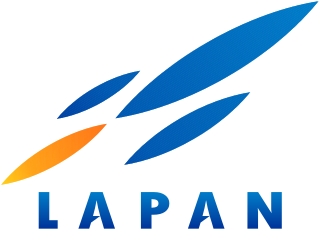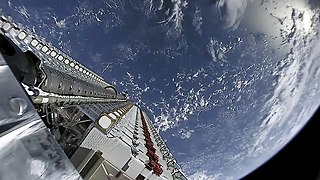Related Research Articles

The Canadian Space Agency is the national space agency of Canada, established in 1990 by the Canadian Space Agency Act. The agency is responsible to the minister of innovation, science, and economic development.

The Roscosmos State Corporation for Space Activities, commonly known as Roscosmos, is a state corporation of the Russian Federation responsible for space flights, cosmonautics programs, and aerospace research.

The Japan Aerospace Exploration Agency (JAXA) is the Japanese national aerospace and space agency. Through the merger of three previously independent organizations, JAXA was formed on 1 October 2003. JAXA is responsible for research, technology development and launch of satellites into orbit, and is involved in many more advanced missions such as asteroid exploration and possible human exploration of the Moon. Its motto is One JAXA and its corporate slogan is Explore to Realize.
ORBCOMM is an American company that offers industrial Internet of things (IoT) and machine to machine (M2M) communications hardware, software and services designed to track, monitor, and control fixed and mobile assets in markets including transportation, heavy equipment, maritime, oil and gas, utilities and government. The company provides hardware devices, modems, web applications and data services delivered over multiple satellite and cellular networks.

National Institute of Aeronautics and Space is the Indonesian government space agency. It was established on November 27, 1963, by former Indonesian president Sukarno after one year's existence of an informal space agency organization. LAPAN is responsible for long-term civilian and military aerospace research.

Spaceflight began in the 20th century following theoretical and practical breakthroughs by Konstantin Tsiolkovsky and Robert H. Goddard. The Soviet Union took the lead in the post-war Space Race, launching the first satellite, the first man and the first woman into orbit. The United States caught up with, and then passed, their Soviet rivals during the mid-1960s, landing the first man on the Moon in 1969. In the same period, France, the United Kingdom, Japan and China were concurrently developing more limited launch capabilities.

Soyuz-2 is a modernised version of the Russian Soyuz rocket. In its basic form, it is a three-stage launch vehicle for placing payloads into low Earth orbit. Compared to the previous versions of the Soyuz, the first-stage boosters and two core stages feature uprated engines with improved injection systems. Digital flight control and telemetry systems allow the rocket to be launched from a fixed launch platform, whereas the launch platforms for earlier Soyuz rockets had to be rotated as the rocket could not perform a roll to change its heading in flight.

The Vostochny Cosmodrome is a Russian spaceport above the 51st parallel north in the Amur Oblast, in the Russian Far East. It is intended to reduce Russia's dependency on the Baikonur Cosmodrome in Kazakhstan. The first launch took place on 28 April 2016 at 02:01 UTC. As of July 2019, five launch attempts have been made with four successes.

The Iridium satellite constellation provides L band voice and data information coverage to satellite phones, pagers and integrated transceivers over the entire Earth surface. Iridium Communications owns and operates the constellation, additionally selling equipment and access to its services. It was conceived by Bary Bertiger, Raymond J. Leopold and Ken Peterson in late 1987 and then developed by Motorola on a fixed-price contract from July 29, 1993, to November 1, 1998, when the system became operational and commercially available.

The Ensemble de Lancement Soyouz (ELS) is a launch complex at the Guiana Space Centre in Kourou/Sinnamary, French Guiana. It is used by Soyuz-ST rockets: modified versions of the Soyuz-2 optimised for launch from Kourou under Soyuz at the Guiana Space Centre programme.

The Soyuz-2.1v, GRAU index 14A15, known earlier in development as the Soyuz-1, is a Russian expendable launch vehicle. It was derived from the Soyuz-2.1b, and is a member of the R-7 family of rockets. It is built by TsSKB Progress, at Samara in Russia. Launches are conducted from existing facilities at the Plesetsk Cosmodrome in Northwest Russia, with pads also available at the Baikonur Cosmodrome in Kazakhstan, and new facilities at the Vostochny Cosmodrome in Eastern Russia.

Planet Labs, Inc. is an American private Earth imaging company based in San Francisco, California. Their goal is to image the entirety of the Earth daily to monitor changes and pinpoint trends. The company designs and manufactures Triple-CubeSat miniature satellites called Doves that are then delivered into orbit as secondary payloads on other rocket launch missions. Each Dove is equipped with a high-powered telescope and camera programmed to capture different swaths of Earth. Each Dove Earth observation satellite continuously scans Earth, sending data once it passes over a ground station. This is accomplished through a technique called a line scan, which allows for continuous, high resolution imagery due to the fact that this type of camera is not restricted to specific vertical resolution.

The OneWeb satellite constellation was a planned initial 650-satellite constellation that was in the process of being completed in 2019–2020, with a goal to provide global satellite Internet broadband services to people everywhere, initially aiming to start global services in 2021. The constellation was being deployed by OneWeb, formerly known as WorldVu Satellites and headquartered in London, with offices in California, Florida, Virginia, Dubai and Singapore.

Soyuz at the Guiana Space Centre is an ongoing European Space Agency (ESA) programme for operating Soyuz-ST launch vehicles from Centre Spatial Guyanais (CSG), providing medium-size launch capability for Arianespace to accompany the light Vega and heavy-lift Ariane 5. The Soyuz vehicle is supplied by the Roscosmos with TsSKB-Progress and NPO Lavochkin, while additional components are supplied by Airbus, Thales Group and RUAG.

Spire Global, Inc. is a space-to-cloud data and analytics company that specializes in the tracking of global data sets powered by a large constellation of nanosatellites, such as the tracking of maritime, aviation and weather patterns.

Starlink is a satellite internet constellation being constructed by SpaceX providing satellite Internet access. The constellation will consist of thousands of mass-produced small satellites in low Earth orbit (LEO), working in combination with ground transceivers. SpaceX also plans to sell some of the satellites for military, scientific, or exploratory purposes. The SpaceX satellite development facility in Redmond, Washington houses the Starlink research, development, manufacturing, and on-orbit control operations. The total cost of the decade-long project to design, build, and deploy the constellation was estimated by SpaceX in May 2018 to be about US$10 billion.

Meteor-M No.2-1, was a Russian satellite, part of Meteor-M series of polar-orbit weather satellite. It was launched using Soyuz-2.1b rocket with a Fregat upper stage on 28 November 2017; the satellite failed to separate from the Fregat and communication was later lost.
Irtysh, also named Soyuz-5, formerly codenamed Fenix in Russian and Sunkar in Kazakh, is a planned Russian rocket that is being developed by JSC SRC Progress within the "Project Feniks". Initially it will replace the capability of Zenit-2 and Proton Medium, and in the future will serve as the base of a super heavy-lift launch vehicle rocket (Yenisei) to match the Energia/Buran capabilities. As of March 2019 It is expected to launch from the Baikonur Baiterek, the ex Zenit-2 launch site, in a partnership with the government of Kazakhstan, with a planned debut of 2022.
ICEYE is a Finnish microsatellite manufacturer. ICEYE was founded in 2014 as a spin-off of the Aalto University, University Radio Technology Department, and is based in Espoo.

Soyuz flight VS22 was a rocket launch conducted by multinational launch service provider Arianespace. It was the sixteenth launch of a Soyuz-ST-B launch vehicle, and the 22nd launch of a Soyuz-2 series launch vehicle from the Ensemble de Lancement Soyouz at the Guiana Space Centre. After two scheduling delays and a 33-minute logistical delay, the rocket lifted off on 4 April 2019, and successfully delivered to medium Earth orbit the final four satellites in the O3b broadband satellite constellation, which services Latin America, Africa, and Oceania. After four previous Soyuz flights delivered the constellation's first sixteen satellites, the launch increased the constellation's throughput by 26 percent. The flight marked the second occasion in which two Soyuz-2 launch vehicles were launched on the same day, occurring hours after the launch of Progress MS-11 from the Baikonur Cosmodrome.
References
- 1 2 3 4 5 6 "S-Net 1, 2, 3, 4 (Tubsat 13, 14, 15, 16)". space.skyrocket.de. Retrieved 2018-02-12.
- 1 2 3 4 "Stabsstelle Presse, Öffentlichkeitsarbeit und Alumni: Medieninformation Nr. 20/2018". www.pressestelle.tu-berlin.de (in German). Retrieved 2018-02-12.
- 1 2 3 4 "Soyuz-2.1a launches from Vostochny with 11 satellites - SpaceFlight Insider". www.spaceflightinsider.com. Retrieved 2018-02-12.